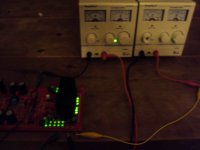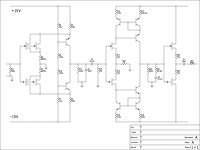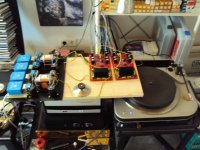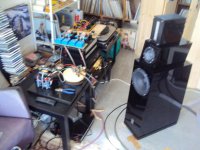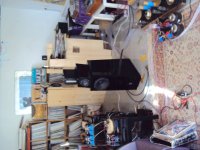The shunt in one channel works ! No problem. I put in +-30V and around 160mA.
The 18V are easy and precise to adjust after some warm up. The cooling fins get warm but not hot. I did not have enough J310 so i put in some J112. They measure very similar and work well.
The 18V are easy and precise to adjust after some warm up. The cooling fins get warm but not hot. I did not have enough J310 so i put in some J112. They measure very similar and work well.
Attachments
Yes, these are rev1 boards. I tried all the tricks I am aware of to get rid of the oscillations, but these are pretty stubborn (stuff for me to learn, I guess ;-)
The rev2 boards do not have that oscillation issue, I think. I did put transistors with HFE=510 in mine and it works beautifully. Don't know what Le'Flu used exactly , but he also has rather high values for HFE. His boards also worked at first turn-on ;-)
I got a few days hollidays caming up and shuld get board finished soon.
I have been slowed down by poor calibration on my Locky_z curve traced
PNP are way out so I am sorting first wit that and thenduble cek with litle Atals unit 510 HFE is good
Would a higher HFE improve the output of the 4 imputs transistors I have few (loads) of PNP and NPN quads at HFE 560 and 580?
Thanks Joachim,
Sorry i have not replied sooner, i usually get an email when replies posted, but didnt this time.
I am hopeing these values will at least put me in the ball park.
Thanks for the link.
Here is my intended diagram. I am hopeing that the addition of resistor R32 in the second stage will reduce the gain in this stage so i can use the RIAA values shown without excessive stage gain, while keeping the input Jfet currents resonably high.
Thanks again
Sorry i have not replied sooner, i usually get an email when replies posted, but didnt this time.
I am hopeing these values will at least put me in the ball park.
Thanks for the link.
Here is my intended diagram. I am hopeing that the addition of resistor R32 in the second stage will reduce the gain in this stage so i can use the RIAA values shown without excessive stage gain, while keeping the input Jfet currents resonably high.
Thanks again
Attachments
Last edited:
I like your circuit !
I have some ideas to improve it but in general it should work fine.
The 1 MOhm resistor and the output impedance of the folded cascode appear in parallel to the RIAA components so it is likely that R12 has a bit to increase.
Also R20 maybe to be raised slightly.
The biasing resistors for the folded cascode are a bit high. 10kOhm would make it.
R7 and R8 can then be decoupled with electrolytics for less noise and more speed.
The 3 transistor mirror in the second stage can be substituted with a 4 transistor mirror we use in the Paradise R2.
Anyway, i think this is a concept for now. It will work fine with some detail optimization.
I have some ideas to improve it but in general it should work fine.
The 1 MOhm resistor and the output impedance of the folded cascode appear in parallel to the RIAA components so it is likely that R12 has a bit to increase.
Also R20 maybe to be raised slightly.
The biasing resistors for the folded cascode are a bit high. 10kOhm would make it.
R7 and R8 can then be decoupled with electrolytics for less noise and more speed.
The 3 transistor mirror in the second stage can be substituted with a 4 transistor mirror we use in the Paradise R2.
Anyway, i think this is a concept for now. It will work fine with some detail optimization.
I have completed now both channels and one is under current.
All voltages look normal.
I think i know the problem that Ricardo has. I have balasted the input with 3.3kOhm and under this condition input offset is around 10mV, BUT when i connect a resistor as low as a typical MC cartridge ( i used 10 Ohm ) the offset disappears. So WITH cartridge connected there is no problem with input offset.
All voltages look normal.
I think i know the problem that Ricardo has. I have balasted the input with 3.3kOhm and under this condition input offset is around 10mV, BUT when i connect a resistor as low as a typical MC cartridge ( i used 10 Ohm ) the offset disappears. So WITH cartridge connected there is no problem with input offset.
Both channels are working, right away !
Not one single components was changed or substituted. No oscillation, i have not even stuffed the optional ceramics. I use only 10% Hfe matching and BCs from several makers,
wildly mixed. This is really fool prove. I am very satisfied.
RIAA has a certain character that can explain partly what Hesener heard. Level is up 0.75dB at 20Hz and levels out at 300Hz, then from 3kHz on there is a small rise, amounting 0.25dB at 20kHz. This stage should have slam and crispiness but not so much that it is not accurate any more. I keep it that way but mathematical artists like Ricardo can tune the circuit to dead accurate if desired. Keep in mind, as i told you before that RIAA precision is somewhat dependent on level. That has to do with the slew limit of the circuit. I give you more details tomorrow and will also listen.
Not one single components was changed or substituted. No oscillation, i have not even stuffed the optional ceramics. I use only 10% Hfe matching and BCs from several makers,
wildly mixed. This is really fool prove. I am very satisfied.
RIAA has a certain character that can explain partly what Hesener heard. Level is up 0.75dB at 20Hz and levels out at 300Hz, then from 3kHz on there is a small rise, amounting 0.25dB at 20kHz. This stage should have slam and crispiness but not so much that it is not accurate any more. I keep it that way but mathematical artists like Ricardo can tune the circuit to dead accurate if desired. Keep in mind, as i told you before that RIAA precision is somewhat dependent on level. That has to do with the slew limit of the circuit. I give you more details tomorrow and will also listen.
Concerning dynamic range the circuit throws around plus-minus 15V P-P so overload is unlikely. The circuit is fast without cascoding of the input stage. It tracks my anti RIAA to over 300kHz, there is the null in my anti circuit. I also tried Heseners anti RIAA. He seems to have used the values for the MM version. Hesener i need the circuit you build and then i can give you the modification that is necessary for MC.
Today i listened for the first time to the Paradise R2. WOW! this is the real deal. It is very quiet, more quiet then i can remember the first version was although i play everything right in the open without cabinet. I use the Opus Magnum Preregulator so i run in complete double mono. That shows up in enormous channel separation. The sound is very big, high, wide and deep but extremely well focussed. There is also wonderful depth perspective, some sounds come near to my head and others sound quite far away. My room has some problem to delineate sounds that come from far away so in a room deeper then mine ( 4.35m ) you will get an even deeper soundstage. Bass is exceptional, already noted by Hesener. It does not only have dramatic slam but is also clear, deep and bouncy without sounding overblown. Fundamentals are well fleshed out and musical. Presence range is perfectly linear and low in coloration and high in resolution. The treble is slightly crispy but very low in distortion. The whole effect is very wide band and dynamic. There is a lightness of tone that is hard to describe. Sound is liquid, maybe not as much as from tubes or Fets but the overriding sensation is like a light spring wind with perfect temperature. I highly recommend that we start the group buy soon.
I highly recommend that we start the group buy soon.
Here is my current setup.
Turntable : Spiral Groove SG1 with Centroid arm and Lyra Titan i cartridge.
Phonostage : Paradise R2 double mono with Opus Magnum Preregulator
Line Preamp : Suesskind prototype
Power Amp : 20W Class A simple symmetric ( Lazy Cat ) modified
Speakers : Suesskind Tangram
Wire : Nordost and Wire-World
Power Filter : Hensler Skin Effect Surface Filter, Nordost Q Box
Turntable : Spiral Groove SG1 with Centroid arm and Lyra Titan i cartridge.
Phonostage : Paradise R2 double mono with Opus Magnum Preregulator
Line Preamp : Suesskind prototype
Power Amp : 20W Class A simple symmetric ( Lazy Cat ) modified
Speakers : Suesskind Tangram
Wire : Nordost and Wire-World
Power Filter : Hensler Skin Effect Surface Filter, Nordost Q Box
